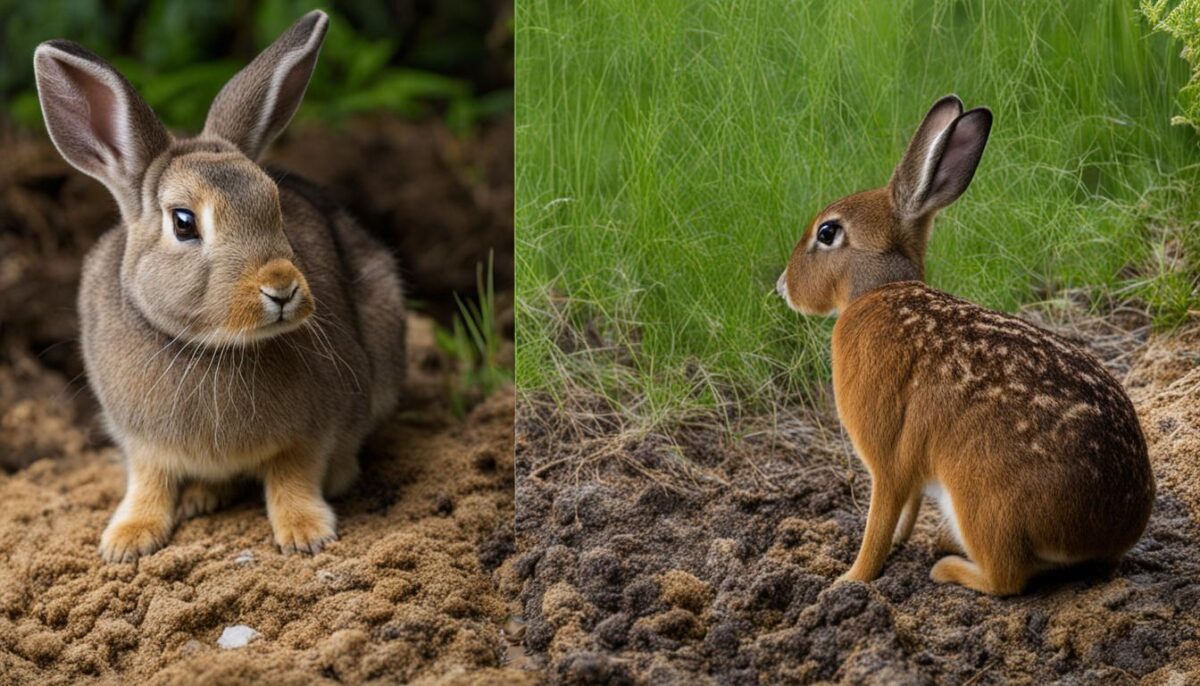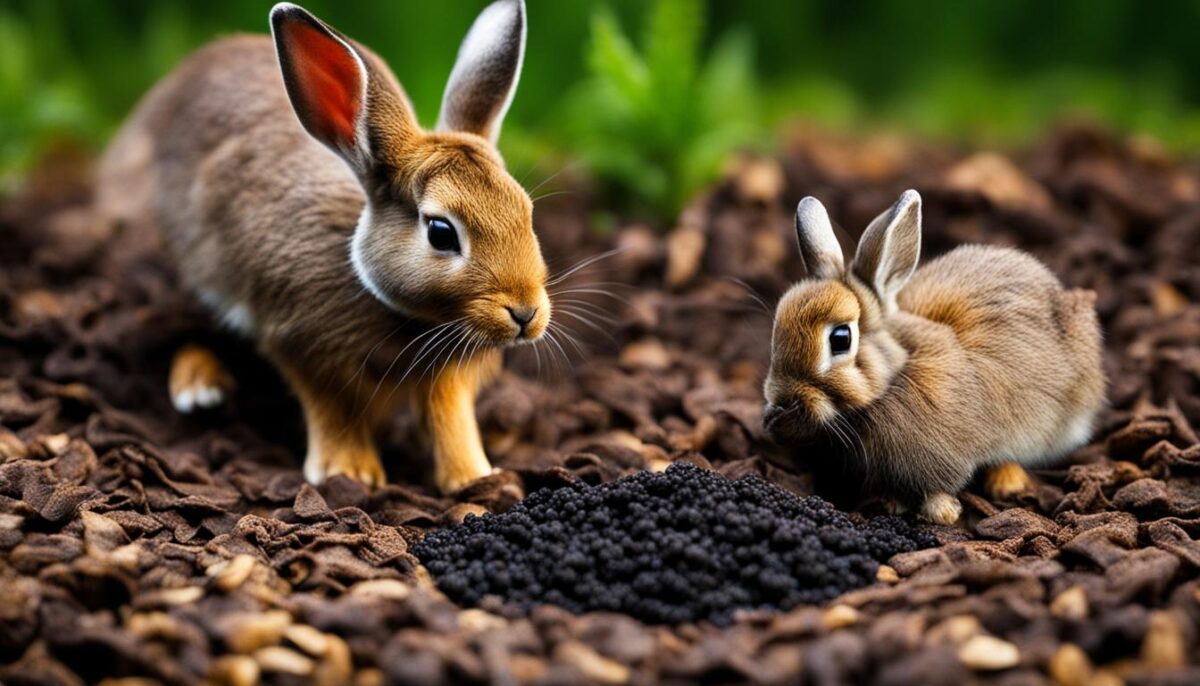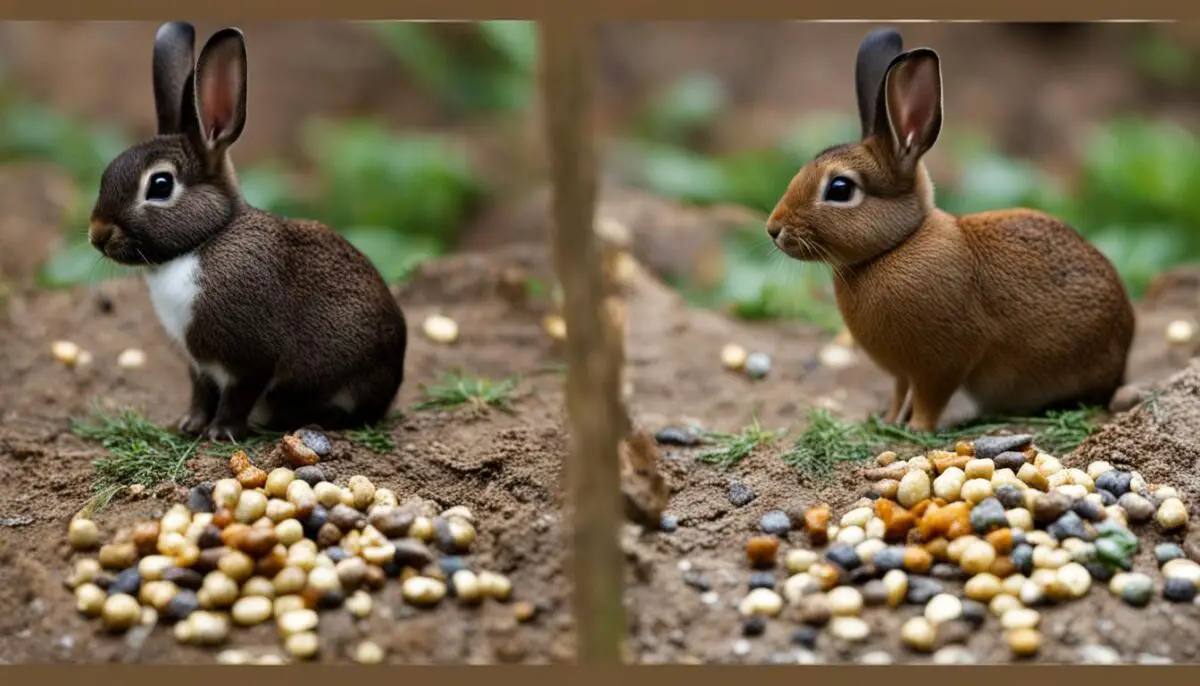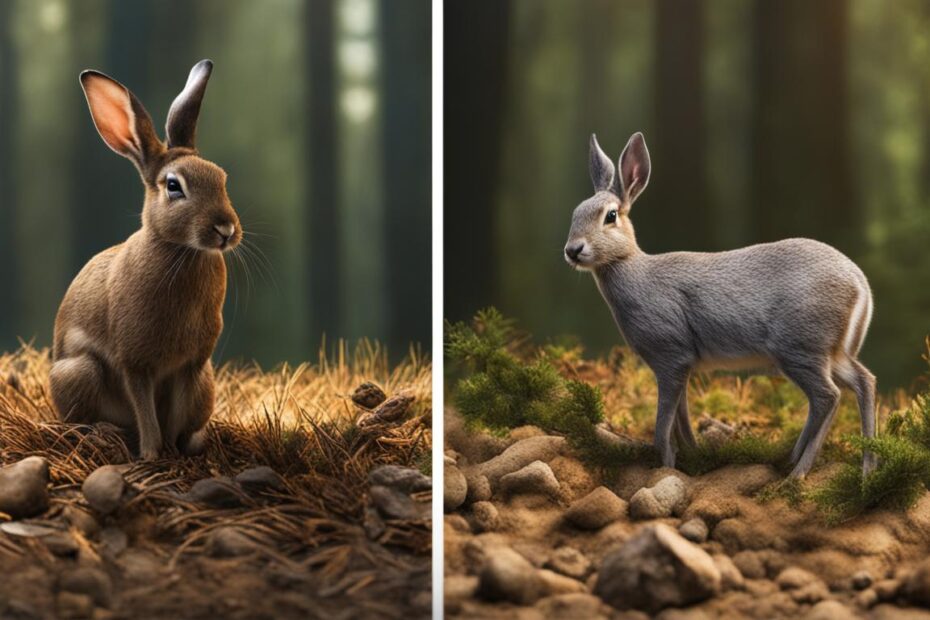Rabbit poop and deer poop are common animal droppings found in outdoor environments. Identifying scat can provide valuable insights into the presence and behavior of wildlife. In this comprehensive guide, we will explore the disparities in appearance, size, odor, and other characteristics between rabbit scat and deer scat. By understanding these differences, you’ll be equipped to accurately identify these animal droppings and gain a deeper understanding of the animals that produce them.
Key Takeaways:
- Rabbit poop and deer poop have distinct differences in appearance, size, color, texture, and odor.
- Rabbit scat is characterized by small, round pellet-like shapes, while deer scat appears as oval-shaped clumps.
- Rabbit droppings are typically smaller and have a smoother surface, while deer droppings are larger and rougher with remnants of plant material.
- The color of rabbit poop is brown or black, while deer poop is dark brown or black.
- Rabbit scat is usually found in groups or clusters, whereas deer scat is commonly scattered in small quantities.
- Rabbit droppings have a mild, earthy odor, while deer droppings have a pungent, musky smell.
- Rabbit poop consists mainly of plant material, while deer scat contains a mix of plant material and browse.
The Appearance of Rabbit Poop and Deer Poop
Rabbit poop and deer poop have distinct differences in appearance that can help in their identification. Understanding these disparities can provide valuable insights into the animals that produce them.
Rabbit poop is characterized by its small, round pellet-like shape. It typically measures around 1/4 inch in diameter. The color of rabbit poop can vary, but it is commonly brown or black, blending in with the natural hues of the environment. Rabbit droppings have a smooth surface with a shiny coating.
In contrast, deer poop appears as oval-shaped clumps and is larger in size compared to rabbit poop. Deer droppings are about 1/2 inch in length. They are typically dark brown or black in color. Deer poop has a rough surface and may contain plant material, such as leaves or twigs.
By closely examining the appearance of the droppings, you can differentiate between rabbit poop and deer poop, allowing you to better understand the wildlife in your surroundings.
Size Comparison of Rabbit Poop and Deer Poop
Rabbit droppings and deer droppings differ in size, with rabbit poop being smaller in diameter compared to deer poop. Rabbit droppings typically measure around 1/4 inch in diameter, while deer droppings are about 1/2 inch in length. This difference in size can be attributed to the varying digestive systems and diets of these two animals.
Rabbit droppings being smaller can be explained by their primarily herbivorous diet, consisting of grasses and other plant matter. The digestive system of rabbits efficiently breaks down these plant fibers, resulting in smaller, more compact droppings. On the other hand, deer have a larger digestive system and consume a wider variety of vegetation, including leaves, twigs, and other woody plant parts. This leads to larger droppings with a greater diameter.
To visualize the size difference more clearly, refer to the table below:
| Rabbit Poop | Deer Poop |
|---|---|
| Size: 1/4 inch in diameter | Size: 1/2 inch in length |
Understanding the difference in size between rabbit poop and deer poop can help identify the droppings more accurately and distinguish between the two animals in outdoor environments.

Color Differences Between Rabbit Poop and Deer Poop
When it comes to identifying animal feces, color can be an important distinguishing factor. Rabbit poop is commonly brown or black, blending in with the natural hues of the environment. On the other hand, deer droppings appear dark brown or black. However, it’s worth noting that the color of the droppings can be influenced by the animals’ diets.
Rabbit poop’s brown or black color allows it to camouflage effectively with the surrounding vegetation, making it harder to spot in the wild. This coloration is a result of the rabbits’ diets, which mainly consist of grass and other plant material. These dietary choices contribute to the darker, earthy tones of their droppings.
Deer droppings, on the other hand, also have a dark brown or black coloration. This color comes from the mixture of plant material and browse that deer consume. Browse refers to the twigs, leaves, and other woody plant parts that deer feed on. The presence of browse in their diet gives deer droppings a slightly different shade compared to rabbit droppings.
| Characteristic | Rabbit Poop | Deer Poop |
|---|---|---|
| Color | Brown or black | Dark brown or black |
| Reason | Plant material in the diet | Mixture of plant material and browse |
By considering the color differences between rabbit poop and deer poop, you can further enhance your ability to identify the droppings and gain insights into the animals that leave them behind. Remember to take into account other characteristics such as size, shape, texture, and odor to make a more accurate identification.
Texture Variation in Rabbit Poop and Deer Poop
Rabbit poop and deer poop not only differ in appearance, size, and color but also in their texture. Understanding these textural differences can provide valuable insights into the digestive processes of these animals and the types of vegetation they consume.
Rabbit Poop Texture
Rabbit droppings have a smooth surface with a shiny coating. They are compact and firm, resembling small pellets. This smooth texture is a result of the rabbit’s efficient digestion process, which breaks down the food into small particles.
Deer Poop Texture
In contrast, deer droppings have a rough surface. They are often clumped together and can contain remnants of plant material, such as chewed leaves or twigs. This coarse texture is a result of the deer’s digestion process, which does not fully break down the plant matter as efficiently as rabbits.
“The texture of rabbit poop is smooth, whereas deer poop has a rough surface and may contain plant material.” – Wildlife Expert
The textural differences in rabbit poop and deer poop are influenced by the animals’ digestion processes and the nature of their diets. Rabbits have a more efficient digestive system, allowing them to break down food into smaller and smoother droppings. On the other hand, deer have a less efficient digestive system, resulting in clumped droppings with a rougher texture.
By understanding the textural differences between rabbit poop and deer poop, you can further enhance your ability to identify these animal droppings and gain insights into the animals’ feeding habits and digestive functions.
Distribution of Rabbit Poop and Deer Poop in the Environment
Understanding the distribution patterns of rabbit poop and deer poop can provide valuable insights into the behavior and habitat preferences of these animals. Rabbit droppings are typically found in groups or clusters, while deer droppings are commonly scattered in small quantities.
Rabbit poop is often found near rabbit burrows, gardens, or lawns. These areas provide a suitable habitat for rabbits, as they offer protection and a readily available food source. The presence of rabbit droppings in these areas can indicate an active rabbit population.
On the other hand, deer droppings are commonly found near wooded areas or trails. Deer prefer habitats with ample vegetation for grazing and cover for protection. Their droppings can be found scattered throughout these areas, as they move and feed over a larger territory.
By observing the distribution of these droppings, outdoor enthusiasts and wildlife researchers can gain a better understanding of rabbit and deer behavior, as well as identify areas that are frequented by these animals. This information can be valuable for conservation efforts and wildlife management.

Table: Odor Characteristics of Rabbit Poop and Deer Poop
| Characteristics | Rabbit Poop | Deer Poop |
|---|---|---|
| Odor | Mild, earthy scent | Pungent, musky odor |
The table above summarizes the odor differences between rabbit poop and deer poop. It is important to note that the odor can vary depending on factors such as the animals’ diet and the age of the droppings. Fresh droppings may have a stronger scent, while older droppings may have a milder smell.
Composition and Nutrient Content of Rabbit Poop and Deer Poop
Understanding the composition and nutrient content of rabbit poop and deer poop provides valuable insights into the dietary habits and ecological roles of these animals. Rabbit droppings consist primarily of plant material, such as grass and leaves, making them rich in organic matter. These droppings are a valuable source of nitrogen, which is an essential nutrient for plant growth and development. The high nitrogen content in rabbit poop makes it an excellent natural fertilizer for gardens and agricultural fields.
On the other hand, deer droppings contain a mixture of plant material and browse. Browse refers to the woody plant parts, such as twigs and leaves, that deer consume. The inclusion of browse in deer droppings adds additional organic matter to the soil, contributing to its overall fertility. Furthermore, deer droppings contain essential nutrients, including phosphorus and potassium, which are vital for the healthy growth of plants.
| Rabbit Poop | Deer Poop | |
|---|---|---|
| Nitrogen Content | High | Moderate |
| Other Nutrients | Low | Moderate |
| Organic Matter | High | Moderate |
Both rabbit poop and deer poop contribute to the overall health of the ecosystem by enriching the soil and providing essential nutrients for plant growth. Their nutrient-rich composition helps support the diverse flora and fauna in their respective habitats, ultimately promoting a balanced and thriving ecosystem.
By understanding the composition and nutrient content of rabbit poop and deer poop, we can appreciate the vital role these animal droppings play in maintaining the ecological balance and promoting sustainable growth in natural environments.

Environmental Impact of Rabbit Poop and Deer Poop
Rabbit poop and deer poop, although different in appearance, size, and texture, both play crucial roles in the environment. These animal droppings contribute to nutrient cycling, seed dispersal, and soil enrichment, ultimately supporting the overall health and balance of ecosystems.
Rabbit poop, with its high nitrogen content, serves as a natural fertilizer that helps fertilize plants and enrich the soil. When rabbits consume vegetation, their digestive systems break down the plant material and release nitrogen-rich waste in the form of droppings. The nitrogen content in rabbit poop provides essential nutrients that plants need for healthy growth, benefiting both wild vegetation and cultivated crops.
Deer poop, on the other hand, contributes to seed dispersal. As deer graze on plants, they consume various fruits and seeds. These seeds pass through their digestive systems and are excreted in the droppings. The scattered deer droppings help spread seeds to different areas, aiding in the regeneration and diversification of plant populations.
| Environmental Impact | Rabbit Poop | Deer Poop |
|---|---|---|
| Nutrient Cycling | High nitrogen content fertilizes plants and enriches soil | Contributes to seed dispersal and plant regeneration |
| Soil Enrichment | Improves soil fertility and promotes healthy plant growth | Assists in the dispersal and germination of seeds |
| Ecosystem Balance | Supports the growth of vegetation and maintains biodiversity | Aids in the regeneration and diversification of plant populations |
By understanding and appreciating the environmental impact of rabbit poop and deer poop, we can recognize the important contributions these animal droppings make to the natural world. Next time you come across these droppings in the wild, consider the vital role they play in sustaining healthy ecosystems.
Using Rabbit Poop as Fertilizer and Safety Concerns
One of the many benefits of rabbit poop is its potential use as a natural fertilizer in gardens and plant beds. With its high nitrogen content, rabbit droppings can help promote healthy plant growth and enhance soil fertility. However, it’s important to take certain precautions and ensure proper handling to minimize any potential safety concerns.
Safety concerns:
- Wear gloves when handling rabbit droppings to protect your hands from bacteria and other potential pathogens.
- Avoid direct contact with the droppings and always wash your hands thoroughly after handling them.
- Compost the rabbit poop before using it as fertilizer to ensure proper decomposition and kill any harmful microorganisms.
- Never use fresh or untreated rabbit droppings directly on edible crops that will be consumed without cooking.
- Keep children and pets away from areas where rabbit poop is being used or stored.
By following these safety measures, you can safely utilize the benefits of rabbit poop as a natural and eco-friendly fertilizer for your plants and gardens.
| Safety Concerns | Precautions |
|---|---|
| Wear gloves | Protect your hands from bacteria and potential pathogens |
| Avoid direct contact | Wash hands thoroughly after handling |
| Compost before use | Ensure proper decomposition and kill harmful microorganisms |
| Use on edible crops | Never use fresh or untreated droppings without cooking |
| Keep away from children & pets | Ensure safety by preventing accidental contact or ingestion |
Remember, proper hygiene and caution are essential when handling any type of animal waste, including rabbit droppings. By following safety guidelines, you can make the most of rabbit poop as a natural fertilizer while ensuring the wellbeing of yourself and others.
Conclusion
In conclusion, understanding the disparities between rabbit poop and deer poop is crucial for accurate identification and gaining insights into the animals responsible. By examining the appearance, size, color, texture, distribution, odor, composition, nutrient content, and environmental impact of these droppings, we can develop a deeper understanding of the wildlife around us.
Rabbit poop is characterized by small, round pellets with a smooth surface and a brown or black color. It is typically found near burrows, gardens, or lawns. In contrast, deer poop appears as oval-shaped clumps with a rough surface and a dark brown or black color. It is commonly scattered near wooded areas or trails.
These differences in scat characteristics can provide valuable information about the animals’ diets, digestion processes, and habitat preferences. Furthermore, both rabbit poop and deer poop play important roles in the ecosystem, serving as natural fertilizers and contributing to the overall health of plants and soil.
As responsible wildlife enthusiasts and outdoor enthusiasts, it is essential to exercise caution and practice good hygiene when handling animal droppings. While rabbit droppings are generally not harmful to humans, it is advisable to compost them before using them as fertilizer to ensure proper decomposition and nutrient release. By following these guidelines, we can appreciate the benefits of these animal droppings while minimizing potential risks.
FAQ
What are the differences in appearance between rabbit poop and deer poop?
Rabbit poop is small, round, and pellet-like, while deer poop appears as oval-shaped clumps.
How can I distinguish the size of rabbit poop and deer poop?
Rabbit droppings are around 1/4 inch in diameter, while deer droppings measure about 1/2 inch in length.
What are the color variations between rabbit poop and deer poop?
Rabbit poop is brown or black, while deer poop is dark brown or black.
What is the difference in texture between rabbit poop and deer poop?
Rabbit poop has a smooth surface with a shiny coating, while deer poop has a rough surface and may contain plant material.
How are rabbit poop and deer poop distributed in the environment?
Rabbit droppings are usually found in groups or clusters, while deer droppings are commonly scattered in small quantities.
What are the distinct odors of rabbit poop and deer poop?
Rabbit droppings emit a mild, earthy scent, while deer droppings have a pungent, musky odor.
What do rabbit poop and deer poop consist of?
Rabbit droppings mainly contain plant material, while deer droppings contain a mix of plant material and browse.
What is the environmental impact of rabbit poop and deer poop?
Rabbit poop helps fertilize plants and enrich the soil, while deer poop contributes to seed dispersal and soil and vegetation health.
Can rabbit poop be used as fertilizer in gardens?
Yes, rabbit poop can be used as a natural fertilizer due to its high nitrogen content.
Are rabbit poop and deer poop harmful to humans?
Rabbit poop is not harmful to humans, but it’s important to practice good hygiene when handling animal waste to minimize potential risks.


